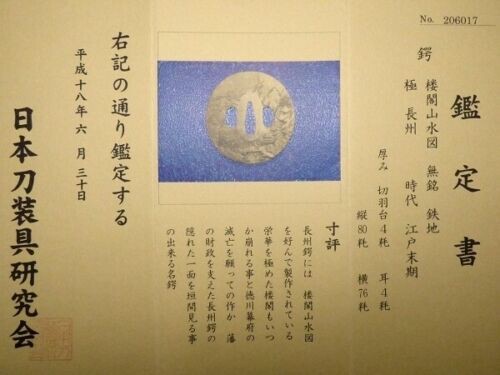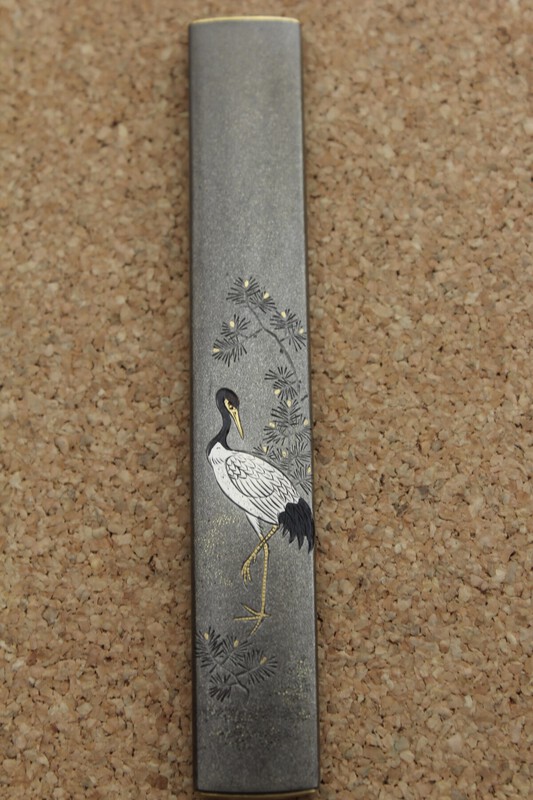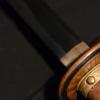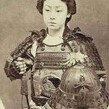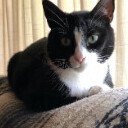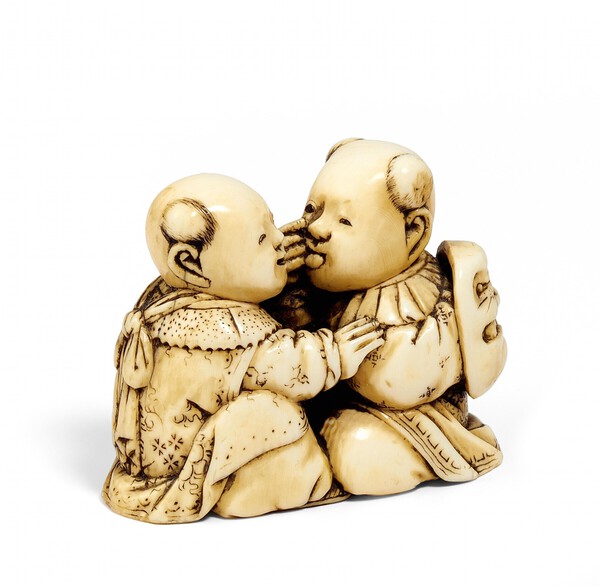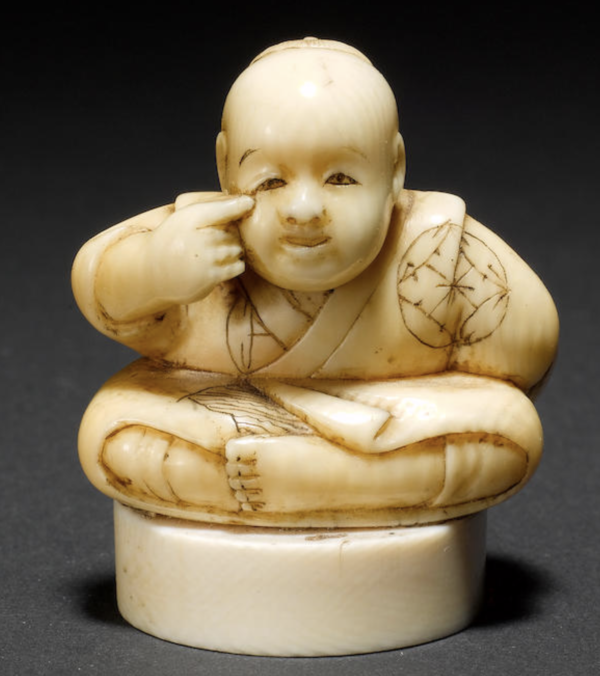Leaderboard
Popular Content
Showing content with the highest reputation on 06/30/2021 in Posts
-
4 points
-
Woah, woah, woah everyone No, I don’t intend to go start whacking at trees etc. My idea of “testing” was using a replacement thumb to press hard, like a hotdog and cleaning it immediately afterwards. My mistake on the word choice; I imagine this community sees a lot of tragedies of the “testing” variety. Aside from my being a good student of history, Id like to think I’m a good steward of history as well. If I wanted a toy, I wouldn’t be spending this much money on it. The importance of its sharpness is a historical curiosity, not a need to have it sharp today. It’s not a parade blade (correct me if I’m wrong), so why isn’t it sharp? You wouldn’t issue a gun that doesn’t fire. I don’t need it to be sharp, and with family at home, it’s better that it’s not.3 points
-
I'll also say, I don't win when I tell someone that the pricing scheme and preciousness of a Nobuhide is different based on the presence or lack of presence of fine horimono. I don't have either to sell anyone. I would love to sell those with the great horimono. 20 years I have never had one. I will never have one. The reason for that is that they are simply too expensive in the Japanese market to procure, document, and then sell. They are already priced where Japanese buyers will support the market and foreigners will not. Foreigners will go for the 75 cm one with no horimono in the belief that they are getting one discounted and not factoring in the horimono. Very few will instead get the 63 cm one with the best horimono and pay the premium price for it. I don't get anything by telling people that there is hazard in buying a $10,000 Masamune with green papers. That buyer is not going to come to me or someone like me for a legitimate one because they won't be in the market for a legitimate one. The guy who is going to buy that one off of Yahoo auctions will not be buying a Tokubetsu Juyo Kanemitsu or Shizu or anything like this from me. I don't save myself anything by trying to inform people on this. I get rocks thrown at me for doing so by the cottage industry in selling dreams to those who want to believe that these have the legitimacy that people want to believe that they do. Every time I say it, I am worried and I have to always say that sometimes yes a green papered anything will end up being OK but the odds are against you and by mathematics they will only get worse every time a diamond is pulled from the mud and promoted to Tokubetsu Hozon, it just leaves behind a greater and thicker concentration of mud. I get nothing but smears for trying to at least tell people and warn them to not get burned by these things. I'm not a seller of shinto in mass quantities and I have nothing but praise for a great work of Nobuhide or Tadatsuna or Sadakazu with one of these great horimono. If I can get them I will but generally I can't for the reasons stated. All I am doing is actually supporting the market for those who *do* have them and can sell them and provide them by vouching for their importance and I don't completely dismiss one without, but when you do buy one without you are missing a great deal of the point of why a Nobuhide or Tadatsuna is held in high esteem. If you're going to buy a muscle car you should get one with a high powered engine or you miss the point of having a muscle car. If you buy a bottle of champagne that's been open for a week you miss the point of buying a bottle of champagne if you buy a Kobe beef steak you miss the point to get it well done. Even if you like it well done with ketchup on it, it's missing the point and in fact you need some education if you think that's how to have it. There may still be some merit in all of these things, which is what sustains the value that they have, but they are not to be conflated with each other or held as equivalent. I get nothing from pointing that out. People get things by telling others that silver and gold are both shiny metal so they are the same.3 points
-
Lol funny. It's kind of the street hucker's go-to move when they're holding out the Rolex in the back alley. Today's your lucky day we have gold for the price of silver here so why go anywhere else? I'd suggest though that you're answering a question with a direct ad hominem and not contributing anything toward bringing the idea to its knees if you disagree with it as you seem to. I would pose the question to you: In the case of an artist famous for his horimono, given two works A and B which are otherwise identical, though B has the addition of a first class horimono by said artist, why would they be held up as equivalently precious examples of his handicraft? If an artist is famous for a particular technique, an excellent example of that technique that makes him famous, will always carry a premium both in value and in interest among knowledgeable collectors. Juyo and Tokubetsu Juyo track this idea. But a huckster exists by promoting the idea that all of this is equivalent because that's what creates arbitrage opportunities for the huckster. This is why the green paper idea won't die in the west. Because there is a community that profits on this kind of confusion. Japanese dealers dismiss these concepts because they are practical and pragmatic and won't try to promote to an informed buyer that green papers are reliable. They similarly will not mix up concepts like Sue-Hosho with Hosho or so on. But if you can conflate these ideas in someone's mind that's what lets you profit. So you tell the buyer that silver is equivalent to gold, and today they are lucky because you're selling silver which is really gold at the price of silver, and they will be smart then to buy the silver. Now silver on its own has its own merits: it's not useless and it's not valueless. But if you promote the idea of conflating the two, then you take advantage of the conflation of ideas by getting the buyer to buy on the idea that they're placing smart money by buying at a discount. So these green papered junkers in Japan that go through the dealing community precisely as this, as junk, are those that get scooped up by western dealers and promoted as papered authentic and reliable masterworks. Those that want to shoot the idea down usually turn to this kind of ad hominem above as their go-to form of persuasion and to continue telling the story that Santa Claus is real. There is always apetite among people to believe this because they want to believe that they will beat the market. This is again, never to say that there are no works among green papered blades that are without merit or won't be promoted to a modern paper. But the idea that it's reliable and problem free and that you should always hope and be positive when you see these things is what the huckster desires to promote in order to keep the market for them alive. It's all about whatever idea you want to carve into the buyer's mind, and those that are concentrating on value, you want to show them that this is the doorway to value. The mint condition 1965 Ferrari Daytona with all original and matching serials then is the same as one that has been slapped together out of spare parts bins, and so the smart buyer should go for the spare part bin item. Or the antique firearm that has modern milled replacement parts is just the same as the one that is all original... or the cracked porcelain is almost as valuable as the same one that is in perfect condition. Or this rare coin with a bit of wear is the same as the one that looks like it came from the mint. Even fractional changes in those things cause great devaluation and increase disinterest among collectors. It doesn't make them bad or valueless but it makes them less precious. If you want a Tadatsuna or a Nobuhide with top flight qualities and you add excellent original horimono to that package, the value and the interest will always go up. That is *specifically the reason* why con artists and hucksters have through history added fake horimono to those works. Exactly because people are more interested in them with the horimono. Exactly because the value is higher with the horimono. This is exactly why good advice tells people to be careful of fake horimono. This is exactly why the smiths added "hori dou saku" to their works, to prove and attest that they themselves made the horimono. Proposing that this is a bad idea without merit because you don't like someone is disingenuous and in fact it's harmful and misleading to people and at the very, very minimum if you want to float that kind of transparently silly claim you should always add a slight bit of support to what you have to say. Otherwise there's only two alternatives, one of which is hucksterism which purposefully misleads people and the other of which is a failure to understand the topic and so spreads disinformation by way of ignorance. These smiths are not just swordsmiths: they are horimono artists and to dismiss the horimono as unimportant, is just one of those two ideas above. Similarly you cannot praise a work with excellent horimono and poor manufacture, but I don't think those really exist because they won't go to the considerable extra effort to make a "one way ticket" of carving a horimono that will kill the blade if one mistake is made. Also you may let Gassan Sadatoshi know that his works featuring excellent horimono are of no particular added interest in the community nor should he charge much more for them than one without, which he does, because you have stated that everything is the same. I'll add at the end of this as well that there are some collectors who do make a living by scrounging through the junk drawers and occasionally find gold. When they hit gold then it proves to them that the method is reliable. I have looked at some of these collections, in which the vast majority was fake and had something less than a 1 in 20 hit rate of authenticity and it's disheartening. Some of it is purposeful, because they are fed this stream of garbage by a junk dealer and every now and then the dealer inserts a nugget of gold. That hit is what sustains the collector because they both love the thrill and risk involved in discovery and that positive hit is confirmation. When they get confirmed by the NBTHK they hold it out as a victory and proof of the method because this great agency has told them that they decided correctly. On the other 19 out of 20 that are pure losses, they wave their hands and say, "What does the NBTHK know? How can they make so many mistakes?" They never see that the two ideas are mutually exclusive that they cannot both dismiss the expertise of the judges while simultaneously basking in their confirmation that one time out of 20 that they hit. Such a collection is a huge misplaced expenditure of money. The one hit does not make up for the 19 mistakes. So this is not about collecting or about art or anything of the sort, it's about the fun of the roulette wheel or fun of blackjack or fun of prospecting for gold. It's gambling and gambling has its own merits and benefits but usually the house wins. You can do the same with penny stocks, you can buy them all day long for years and 1 time out of so often you will hit and win huge, get your 10 or 20 or 100 bagger. But the vast majority of penny stocks just expire as dead companies and no value. You can wave your finger at the person who bought the boring blue chip expensive stocks all along and promote the idea of gambling or that penny stocks are a wise investment choice. At the end of the day the person with the boring porfolio always did well. They didn't beat the one gambler out of 100 that sold their house and dumped it all into GME one year ago, but they didn't take the risk either of losing everything so as a whole, that group, made great decisions and gets to sleep at night and doesn't have to micro manage their assets. Anyone who invested for a long time knows the pain that one bad call on a high risk stock that goes to zero neutralizes 10 good decisions on boring, solid, reliable investment decisions. There is a parallel in art and collectibles always. The Honus Wagner card that raised eyebrows for being the first over one million dollars is now 4 million or so. It's a blue chip among baseball cards. You would have been better off speculating if you made all the right decisions on day one about rookie cards as they came out, but mostly people don't do that. But if you bought the best one, you never did badly and you also got to relax in the idea that you have the best one. Such is a Nobuhide of first class manufacture plus first class horimono. It's the blue chip among the smith's works and anything that detracts from *any* aspect of the smiths' repertoire causes a degree of disinterest and that degree of disinterest reflects directly in the value. And so the worn out coin that a dealer tells you is as good as mint one, or the shiny rolex on the street corner that they're going to tell you is just the same and also tells time the same way. They are not equivalent even if they appear to be equivalent to the uneducated eye. In the end, these claims you make of equivalence between a work with top class horimono and one without, or say of a drawer full of reliably papered Masamune at Tokubetsu Hozon that do not impress you, these are very, very, very simple claims to substantiate without having to rely on sophistry. You simply can produce the examples in question. Please find and sell a work of Nobuhide with high class horimono for 2.5 million yen, or to hold your nose at the unimpressive Masamune at $60k, buy those and put them on the market at these prices for those of us who want them, to buy them. I will buy them from you, any day of the week. I am waiting here with my money in hand, holding it out, and waiting for my great horimono Nobuhide and my unimpressive Tokubetsu Hozon Masamune. Please endure the assault on your senses by such needless unimportance as a great horimono by a great horimono artist or a Soshu work so unimpressive as both to qualify legitimately as Masamune and yet not possess the qualities of being able to pass Juyo. I will buy from you, I am absolutely serious. I will buy a great sword from the ghost of Hitler if he will provide it to me, I will buy from the sensei of Facebook if he has a great sword to sell. I will buy from you or anyone, I do not care because I am absolutely a pragmatist and I don't conflate the work or its greatness with my personal feelings about the person providing it. I would also advise my customers to buy from my arch enemies who hold the only thing important in their lives to hold a 15 year old grudge to try to attack me personally. I will say go straight to them and buy the masterpieces if you can get them. And so will I. As recently as two weeks ago I told a customer on this board to withold payment due to me for an existing purchase, because another dealer presented to them a very nice item for acquisition that will fit in his collection. Others can testify as well that I have recommended blades for sale by other people. All I care about is greatness. Not conflating green papers with reliable things, and not telling someone that there is no significant difference in appreciation of works of a great horimono artist regardless of the presence of said horimono. Some of these ideas, if you proposed them in the company of top flight dealers in Japan, that the horimono is not an important component of these smith's works that are famous for horimono, or that Masamune are a dime a dozen with Tokubetsu Hozon papers laying around in quantity, nobody would challenge you on it. They would just look at you and if you were viewing such a work with great horimono they would just quietly put it away and bring you one with none. Afterwards they would tell jokes among friends. The same way that they do when a beginner complains about a kitae ware on a Heian blade and they put it away and bring them a Shinsakuto. They are pragmatic. They will not rattle your cage or disabuse you of these notions unless they care about you. And they primarily want to sell. Unless you are blessed with a great relationship with some of those guys you will just be allowed to believe what you want to believe. Anyway I want you to just bring these to market. Find it if it really exists. Post it here for sale and I'm ready to buy either these Masamune and I will take my chance on your tastes being equivalent to mine or not. I will buy all Nobuhide I can get with great horimono by the smith provided they are authentic in the 2.5-2.8 million yen range that you can find the katana without. I will also accept Mitsutada or Go. I'm flexible. Just don't pee on my leg and tell me it's raining with these conflated ideas. Mumei Sue-Bizen is not the same as Kamakura Bizen though they are both Bizen, Tokubetsu Kicho is not the same as Tokubetsu Juyo though they both say Tokubetsu and Nobuhide without horimono is not the same as one with though they are both by the same maker.3 points
-
Danger zone refers to the liquidity in the market and the time horizon needed to conclude a sale. Liquidity concentrates at the bottom (0.5-5K blades) and at the top (ultra desirable rarities), the bottom of the ladder of each categories (e.g. "CHEAP" JUYO or "CHEAP" Big Name) and the roulette blade (no papers, green papers, etc). The reason for the top categories is that there are a couple of big whales in Japan with museum-level ambitions that will gobble up the top of the inventory of each dealers and leave the rest for them to "sort it out" with broader retail. Sometimes the whale leave something precious behind, sometimes someone doesn't want to deal with the whales, etc. They aren't gentle whales, but rather great whites one could say. At the bottom you have constant demand due to the collectors who focus on having a lot of blades and new entrants in the hobby. There will always be a market there. This is self-explanatory. Then you have the bargain seekers who see a Juyo blade for 1.5M yen and think it's mispriced and will jump on it immediately. Often the blade in question will end up being something like a Juyo 21 Yamato Shikkake Wako which is fugly and unremarkable overall, with no chance of passing Juyo today. Cheap Juyo is a very liquid market in the West because what you're doing is essentially sending signals that you're undercutting Tsuruta, and since everyone uses Tsuruta for price discovery, it works very well and sells fast. Danger zone is when you're not anywhere near any of these three categories. A good shinto smith like Nobuhide with TH paper is right into the danger zone. Too expensive for new entrants, too expensive for the bargain cheap juyo hunters, and undesirable by the whales. The only way out is to flush is by taking a substantial loss, or sell it on consignment and wait for eons. The roulette blades also appeal to a broad range of bargain hunters. In some cases, it's even advantageous to toss the hozon (small name) in the bin and to put up the green papers (BIG NAME) in the auction alongside with some dubious old provenance to get the apes to gamble. Especially for things like HIROMITSU (green paper) / Shimada (hozon) or MASAMUNE (green paper) / mumei shinto (hozon) etc. These generally find a good home on Yahoo auction, but you'll find them sometimes in big auctions in Europe. Most important is that the blade needs to look somewhat like an old thing. Add a coffee-stained "honami origami" and a fake Sayagaki and you're in business. I wouldn't recommend going there... And there is nothing wrong with collecting the danger zone. if anything it's the honorable pond to fish in because it's born out of love and not greed. Just know what you're getting yourself into.3 points
-
A quick update on items that I now have for sale. If there is anything that you would like more information on, please reach out to me at raymondsinger@gmail.com. Eikyo Bizen Yukikage katana with flamboyant choji-midare hamon and utsuri - $6,250 (plus shipping & PayPal) Massive katana by Kozuke no Suke Minamoto Yoshimasa - $8,750 (plus shipping & PayPal) Omi Daijo Tadahiro wakizashi, Tokubetsu Hozon with an abunome-gonome hamon in the style of shodai Masahiro - $6,750 (plus shipping & PayPal) Shodai Hizen Tadakuni wakizashi, Tokubetsu Hozon - $5,950 (plus shipping & PayPal) Hokuso Harukuni wakizashi with kinpunmei - $4,750 (plus shipping & PayPal) Yokoyama Bizen Nagahiro katana, an elegant sword in suguha with ko-itame hada - $4,950 (plus shipping & PayPal) Zaimei Shimosaka sasaho-yari which appears to be an utushimono of Tonbogiri - $4,950 (plus shipping & PayPal) Several excellent wakizashi by the Shitahara smith Hiroshige, Shigenobu and Yasushige - from $3,500 (plus shipping & PayPal) Monju wakizashi - from $2,500 (plus shipping & PayPal) Ubu signed and dated wakizashi by Tsuguhide - $2,500 (plus shipping & PayPal) Muromachi period Sue-Bizen Norimitsu yoroidoshi in hamidashi koshirae - $4,250 (plus shipping & PayPal) Top-quality gendaito by Tamura Tomeji Akitaka, Ueno Kanemitsu, Ogawa Kanekuni, Hizen Yoshitada, Matsubara Hidemune, Ugo Kuniyoshi, Okimitsu, Kanetoshi, Mikawa Takenori, Baba Tsugukiyo, Miura Kunimitsu and others - from $3,950 (plus shipping & PayPal) Henmi Yoshitaka katana in shirasaya - $9,250 (plus shipping & PayPal) Ubu zaimei signed Mino Kaneuji (Muromachi) hirazukuri wakizashi - $7,500 (plus shipping & PayPal)3 points
-
3 points
-
Hi Michael, Sorry for jumping the gun, but you’re right some people do silly things with very nice swords. I think this is one of those situations where your guess is as good as anyone’s. With Kai gunto, whilst intended for use, it was perhaps the case that there was an awareness that there was little likelihood of it being used on a ship. The days of boarding other ships at sword point were long gone, so maybe these blades didn’t get the same degree of attention as army swords given the pressure to keep churning swords out during the war. It might have been actual policy or practice at the time or something as simple as the owner was about to miss his boat and didn’t make it to the work shop - some personal circumstance. We’ll probably never know, unfortunately.2 points
-
2 points
-
Well, it's been a year since I started this thread. I've covered most of the (blatant) tricks that have been circulating lately, so at a good stopping point. I think that's the end of my updates. Thanks, all.2 points
-
Piers is correct! To be exact, the first one is “Maru ni Kaga umebachi”. Because of the little sword tips between…..2 points
-
2 points
-
2 points
-
Hi Ed, given the size and patina, my first impressions are that it’s modern, but a nice piece and, as you say, well crafted. I’m sure you’ll get some better informed comments than mine.2 points
-
江州 Gōshū 彦根住 Hikone-jū Its a location name: Hikone (city) in the province of Gōshu2 points
-
Agreed ...I even gave them a heads up being very polite as to not make the mistake of a new hobbyist making the wrong decision. You can't tell any of those guys though. I usually tell them I wouldn't take that sword for $200 free shipping just as to be as honest and direct as possible yet somehow they think I'm still trying to work out some angle to rip them off. I can't stand one of the guys on Ebay in the Military listings selling everything as a WW2 family ancestor sword. One of the swords isn''t even signed. Bat s**t crazy I tell you.2 points
-
Today I drove down to Kamakura to visit my friend Robert Hughes (well, being one of those jaded, elitist nihontō pricks, I don’t have any real friends, but Bob is the next best thing). After some hearty lunch next to a beautifully maintained Japanese garden we strolled to the Hongakuji Temple (本覚寺) of the Nichiren sect (日蓮宗). Ashikaga Mochiuji (足利持氏) built, and then donated, this temple to the priest Nisshutsu (日出) on the site where Nichiren stayed at after returning from his exile to Sado (佐渡島); the temple houses some of the ashes of Nichiren. A stone monument stands near the main temple in honor of Okazaki Gorō Masamune (岡崎五郎正宗). The story goes that when Okazaki Gorō, still a boy, came to Kamakura, Nichiren had already taken up residence in the Ebisudō (夷堂) Hall. Gorō 's father brought him to Nichiren to learn his teachings, and in return Nichiren gave the boy a new name, Masamune - which implies the rightness of the teachings of Nichiren himself. Nearby is a prayer column dedicated to Masamune, dating from the Muromachi period and finally there are the gravestones of Masamune and his son Sadamune; they date from the Nambokuchō period, and all inscriptions are eroded. To be fair, there are (yet) no hard facts or documents to support all this, only circumstantial evidence. Further research is needed to corroborate all of this. *** See, Bob, you censuring me for taking photos while you explained all this to me was totally uncalled for – I actually *can* multitask! Oh, and if I got something wrong, it’s only because you didn’t explain it correctly.1 point
-
John, totally fine! I think we all have an obligation to try to stop shenanigans like that. That’s exactly what my wife said about missing his ship's sailing. I suppose we’ll never know. Interesting to think about the officer who owned it. That concept and connection is part of the magic of this topic.1 point
-
Choshu-lite ? Perfect for making into a belt buckle and doing some country line dancing.1 point
-
Michael you made a good deal with that sword. Don't touch it with a bad treatment. Leave it as it is and give it a good care to the next 80 years.... Don't play around with that sword - sharp or not it is not important.1 point
-
1 point
-
Michael - Yes we used to do Iaido demonstrations at the old theater on base - different crowd than those outside the gate. Bakumatsu Meiji history is a favorite of mine so even if its light on sword related material I am going to look up a copy... -tom1 point
-
Dear Yas san Thank you for your efforts to teach us the tricks used by people who caste tsuba and other fittings. You have opened people's eyes. I must admit that the 3rd, 4th and 7th items shown would have caught me. I have enjoyed the journey that you took us on. I hope that some time in the future you will continue this trip.1 point
-
There is no such thing as Japanese sword sharpening. This is a product of the entire polishing process. To sharpen would mean an expensive polish. Unlikely anyone did that deliberately that was in the service. They aren't razor sharp. Paper cutting is meaningless. If it has an edge that will cut when you run your thumb over it hard, that is likely all that was needed at the time.1 point
-
Kaga! Ah, good spot. It could also be described more generally as 剣梅鉢 Ken Umé-bachi. (Like Ken Katabamé, etc.)1 point
-
Hi Vlad, Have you bought or are you thinking of buying these? The photo of the top (attributed) tsuba is entitled "ChoushuCastle2" and the style of this tsuba (manufacture and theme) fits with the Choushu school description though the carving is perhaps clunkier than I would expect. I can't make anything out from the paper as it's too small and blurs when magnified. The lower tsuba might also be Choushu school too based on the style of manufacture. I find the theme and arrangement of the oxen, tree and flowers and the use of space the more pleasing of the two. I don't see anything to suggest that they aren't genuine. Here's an example from Aoi Art: https://www.aoijapan.net/tsuba-the-signature-is-engraved-choshu-hagi-jyu-○○-mitsuyoshi/ Edit: On the paper I think I can just make out: 時代 江戸末期 Jidai - Edo sueki - so the paper is giving it to late Edo period. Can't see the school that the paper attributes it to.1 point
-
Item No. 69 - Kozuka in shibuichi with gold , silver , copper and shakudo Subject of crane and pine , with rising sun on rear. The shibuichi ground has almost an iridescence , from the silver content . Another of these pieces that glow in the hand , very difficult to portray through photos. Signature - Tomei with kao . The kozuka was taken to Japan in 2009 , when we visited the DTI and a TKK gathering , to canvas opinions on this and some other pieces , amongst other things. Three Japanese sensei looked at it and said that they could not decide on authenticity and it should be sent to shinsa . I asked them not to be just polite about it , but they said they weren't and really could not decide - I still think they were being polite about it... As usual , any help with Wakayama images or other pointers would be gratefully received - Thanks ! Hopefully these pictures will give an idea of the quality of workmanship.1 point
-
The central Mon design is Umé-bachi but one of those is 丸に梅鉢 Maru ni umé-bachi and the other is 木瓜に梅鉢 Mokko ni umé-bachi. NB Umé is Japanese apricot (flower) often referred to as ‘plum’ to which it is distantly related.1 point
-
1 point
-
Welcome Michael! I'm sure that you will enjoy it here. Love to hear about your time in Japan and the swords that impressed you there.1 point
-
Welcome Michael - Having lived in Kamakura we used to go to Yokosuka to the movies and we did demonstrations on "Open Base" days. Youve got the right books there and I see one that I'm going to need (Meiji no Senso to Yokohama) - thank you for the recommendation! -t1 point
-
Hello and welcome! I have found the Connoisseur’s Book of Japanese Swords by Kōkan Nagayama to be a very useful addition to my library. There are other great titles listed in the forums FAQ section.1 point
-
1 point
-
1 point
-
Michael - My usual advice to first time visitors is "Leave your wallet at home!" - you'll see so much good stuff you can fill up a suitcase pretty quick. Seriously though Grey has covered what you need to know - if you get to the show and have questions you can ask any of our members - recognizable by the black and white happi coats - we are happy to point you toward persons who collect in a certain area or answer general questions about sword stuff. Since there are booksellers there if you find you need a reference while making a purchase decision many folks will be happy to lend you a book so you can do your research on the spot. If your wife likes decorating there are often paintings, scrolls and woodblock prints along with pottery and other things to look at - if she likes kodogu there will be lots of good stuff to eye and one of our members even makes her own jewelry from kodogu. If she'd prefer a long walk there is a beautiful bayside promenade just outside the hotel that is popular with locals. Give your self plenty of time to see everything, keeping in mind that some table holders will duck out during meal times so you may have to circle back to catch them "at work". Do take the time to introduce yourself and do give us your feedback afterwards as we are always looking to improve the experience for folks... -tch1 point
-
Hi Michael, If you will attend only one day, Saturday will be best. You can take in the Care & Handling talk (usually 10 AM) and the NBTHK/AB, also usually, puts on a show of treasures sometime during the day. Make sure you do know proper handling (https://nbthk-ab2.org/sword-characteristics/ and scroll down) and always a nice idea to ask permission before picking up a sword to look at. Be sure to ask all the questions you have and once asked, listen. The show is quite informal; don't worry about fitting in. If you buy a sword you can get it home in a checked bag, although you'll need a gun case or something similar for a long blade. I'd include a note to TSA, placed on top when the bag or case is opened, explaining that the bag contains an antique sword and no firearms. You can ship the sword home to yourself. I recommend registered mail form the post office (if you live in The States), using a stout tube and the requisite stampable paper tape to seal the tube. Registered is the safest shipping option for valuable items and, once you get above $1,00 or so in value, it is less expensive than regular priority with insurance. Another option for getting a sword home is asking the seller if he is willing to take it home and ship to you. Not all dealers will be willing but I know I would be. Have a mekugi nuki for removing pegs with you; gloves aren't necessary. Areas you should be particularly studying before hand? All of them. Lots of people are planning to attend. You'll have a great time; stop by Mark's & my tables and say hello. Grey1 point
-
http://www.ncjsc.org/item_tanaka_yoshikage_tsuba.htm "Tanaka" Yoshikage 義景 (c. 1850) Certification: NTHK Yoshikage was a student of Tanaka Kiyotoshi 田中清壽, and worked in Shiba in Edo. His works are mainly in the style of the Tanaka School. His family name is Morikawa 森川, and he used the art names of Hoansai 宝庵斎, and Hoshinsai 宝真斎. This iron tsuba exhibits the original, and much admired, red-brown patina this school was known for, as well as the rust these tsuba were prone to develop. As can be seen in the photos, there is no more rust on this tsuba today, then there was when this tsuba was photographed for "The Naunton Collection" catalogue, around 1912, shortly after this tsuba was made. At that time this tsuba was only 50 or 60 years old. Much of this rust can be reduced, leaving a much nicer look, as seen on the top quarter of the back view. The iron plate has a waxy, slightly irregular, surface and looks like stone or leather. Much of the gold on the tree and branches is applied very thickly using nunome, with few hints visible as to the method used. This subject was very popular among the rich merchants of Edo, in the late Edo period. A very similar treatment of this theme was done by Natsuo.1 point
-
Here a link about this seller Always high price (lot gimei or in bad sheap) and seem he dont have a real shop.but post nihonto stuff from other seller in Japan. Be careful1 point
-
Adam, these TSUBA were mostly made for tourists. A handmade (signed) TSUBA was used to make a mold, and so many copies with the same - irrelevant MEI - were sold , probably at the end of the 19. /beginning of the 20. century.1 point
-
Barry; It is obvious that I am referring to the NBTHK panel, I have no confidence in the shinsa held outside Japan. That said, 5 opinions are better than one (they are all true experts) and especially limit the risk of error, we have a bit the same thing in science with the peer-review system.1 point
-
Was a cool blade and did tempt me but ideally looking for something katana length. So still searching!1 point
-
Steven, My ebay spidey sense was correct. That description was the exact style, terminology and an exact showa22 listing description copy. Glad to hear it didn't go far enough for you to be out any money or further complications. I'm also a huge fan of lacquered bohis. Have one already and it's easily my favorite blade even as my collection has grown after buying it. Still hoping this post may have the chance to buy one enter my messages/life.1 point
-
1 point
-
1 point
-
Dear Bob, Number 29 is a very rare subject on tosogu. It is the Akambe Game being play by two boys, and the boy on the kashira is doing the Bekkako gesture (pointing to his eye or pulling down his lower eyelid meaning "do you see any green in my eye" while slightly sticking out his tongue). When playing this game, a mask (Okame or other Noh character mask) is often hidden, so there may be a mask on the other side of the fuchi or perhaps on the menuki or tsuba. While they are very nice and expressive, I think that your instincts are correct about them not being Joi level... Here's the subject on netsuke:1 point
-
Thanks for sharing Bob. I'm sure that many of us wish that they were for sale rather than show.1 point
-
Hi Bob, On Number 24, instead of First Master of the Yagami School (Haynes Index no. H05200), your tsuba is by the Third and final Master of the Yagami School (Haynes Index no. H05202) who was a descendant of the First Master (see Haynes entry below). The tsuba reads: Nagasaki kuni ju nin ("living in Nagasaki"); Kounshi kore [wo] horu ("Kounshi this carved"); Yagami Mitsuhiro. He was the son, nephew or grandson (it is unclear) of the First Master.1 point
-
Tony, as a craftsman, I am used to look at traces of tools which are not visible in the photos. The lines are not sharp, the SAKURA flower does not look as if it was filed to shape, the water wheel seems to lack file traces in the SUKASHI (all 'angles' are round), and as Stephen remarked, the water droplets on the waves seem to be 'cast in', not set in with brass or gold (?). Some of these effects can be influenced by corrosion, so my observations are just what I see from the photos. These are just a few hints, but if you want an expert's opinion, you should ask Ford Hallam.1 point
-
Dear Chuck, sorry your tsuba is a modern fake - a cast tsuba. You can tell this by how the mei has a pressed in (instead of carved) look and the way the other details have been smoothed over in the finishing process (along with molding lines in the sukashi and casting investment remaining in the crevices). I think that Grey is making a joke about Barry's accidental misspelling of cast as "caste".1 point
-
...far from being that, Piers... I found about 11 families “registered” for this exact mon. As Piers said, mostly associated with the Wakisaka lineage (脇坂氏). Amongst the others are: “曾雌” (Soshi) ”中井” (Nakai*) “向坂” (Sakisaka) “黒川” (Kurogawa) ”中村” (Nakamura*) “小林” (Kobayashi*) “恒川” (Kakigawa*), to name a few.... Note, (*) means, several readings possible!1 point









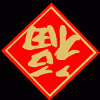

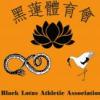


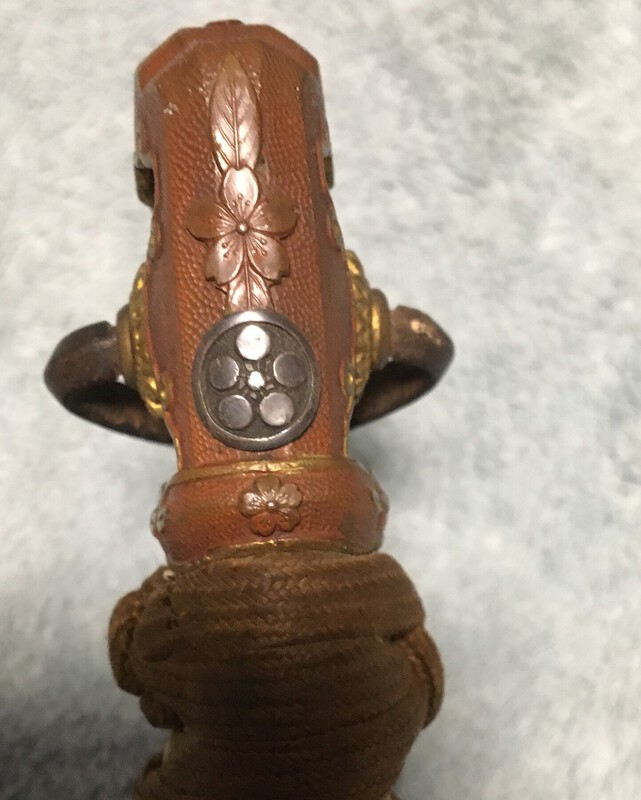

.jpg.9bbbe071257217a2343a2500a3bae3b4.jpg)

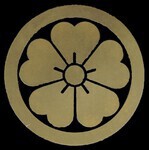
.thumb.jpg.16bf5cc360347306b620b1ae94acfc90.jpg)
.thumb.jpg.882e2ac86c347d73c8b06703fa90a03e.jpg)
.thumb.jpg.29fc3589e7bd887201502ddc0fa88666.jpg)
.thumb.jpg.f7ab98e8d0192625a6c844fbb6e399cf.jpg)
.thumb.jpg.b6c0098032580658ac47fe25205218a6.jpg)
.thumb.jpg.cc44b7ead20cba3b55e8d848183d8924.jpg)
.thumb.jpg.512ab6dc61670f32700697919079c575.jpg)



